Finishes
Fire Protection
Intumescent Coatings
Intumescent coatings simultaneously provide a fire resistance rating and a painted appearance to exposed steel. They contain a resin system "pigmented" with various intumescent ingredients that under the influence of heat, react together to produce an insulating foam or "char". This char layer has low thermal conductivity as well as a volume that is many times that of the original coating. The char layer reduces the rate of heating experienced by the steel, extending its structural capacity and allowing for safe evacuation. As this material can extend the fire resistance rating of exposed steel to a maximum of 2 hours, it has become quite popular for use with AESS applications. The fire resistance rating is in part dependent on the type and thickness of the coating as well as the type of fire that might be anticipated in the building use. Increasing the fire resistance rating is usually achieved by applying multiple coatings of the product.
This video shows the effect of fire on an intumescent coating. The char protects the steel from heat. The length of protection varies as a direct result of the thickness/type of coating as well as the weight of the steel. |
The required thickness of the coating is in turn determined by the thickness of the structural steel member. Thin or light members will require more coats than heavier members. It is sometimes more cost effective to increase the thickness of the steel as it can decrease the number or thickness of the intumescent coatings - the increased cost of steel being significantly less than the extra cost to increase the thickness of the intumescent material. Structural steel is inherently a more sustainable material, so the reduction of the amount of coatings is preferable.
Intumescent fire protection application is preceded by the application of an approved primer. Not all primers can be used so you must check with your Intumescent coating supplier to determine an acceptable primer. If the wrong primer is applied it will interfere with the successful application of the intumescent coating system.
Traditionally, intumescent coatings have been applied on-site to steel structures during the construction phase of the building. In-shop application is currently a more common practice as better control of application conditions is possible. Shop applications can provide for the controlled venting needed for solvent based systems. Shop conditions can also provide more control of temperature and relative humidity, and hence better drying. Controlled drying in the shop means better finish as the coated steel sections cannot be moved until they are hard enough to resist damage. These members must be more carefully handled during transporation and erection as any damage must be properly repaired in order to preserve the integrity of the fire protection system. Colour matching can also be an issue in repairing damage if the paint batch is not identical or if any colour fading has happened.
Intumescent coatings are either Acrylic or Epoxy Based. Acrylic coatings can be either water or solvent based. The Acrylic coatings are field applied. The water based material is "greener" but takes somewhat longer to dry and is mostly used for interior applications. The solvent based coating is more robust and can also be used on the exterior.
Epoxy coatings are normally shop applied and can be used on interior or exterior applications. They are more durable than acrylic coatings and can also be used to provide corrosion protection. Where access for finishing may be an issue, shop applied epoxy coatings may offer savings.
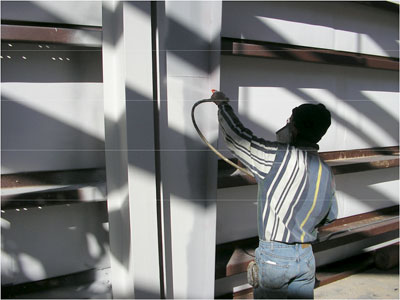 |
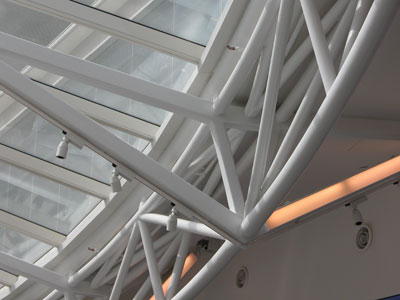 |
Here we see intumescent fire protection being spray applied. Depending on the fire rating and type of coating, multiple coats may be required. Adequate drying time between coats is essential. |
The type of detailing on the truss in this atrium lends itself to this sort of more matte finish. The intumescent coating also permitted this truss to be AESS. |
Water based coatings are typically applied when relative humidity is between 40% and 60%. Solvent-based coatings can be applied with relative humidity up to 85%. If there is concern about the presence of high VOCs on the project, a water based product can be used if the humidity levels are kept low. It is important that the layers are allowed to thoroughly dry between coatings. Water based products take longer to dry where humidity levels are high and temperatures are low. Solvent based products can dry faster but can also strike back to dissolve prior layers if insufficient drying time is permitted between layers.
The intumescent coating system can include a "top coat". This provides a hard protective coating to the product. It is important to note that white or light colours will tend to yellow with time, so if colour matching is an issue, this should be taken into account when mixing intumescent and painted finishes in a project. If combining intumescent and regular paint finished steel note that exact colour matches are not possible. The nature of the intumescent finish will alter the colour of the coating. It will be necessary to detail the structure to account for this slight change in hue or tone. Without a top coat intumescent coating surfaces don't clean as well as with a top coat and will also show finger prints. Any portion of the structure at "hand" level should have a top coat for ease of cleaning and maintenance ant to prevent permanent blotching and stains.
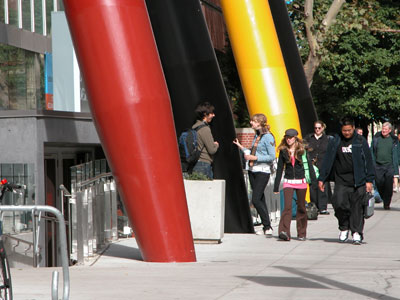 |
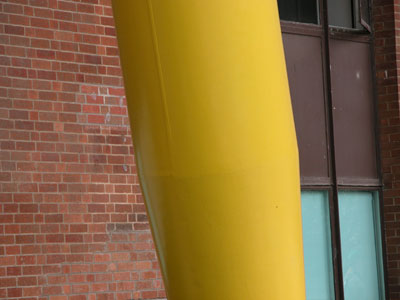 |
The 29m long legs of the Ontario College of Art and Design have been finished with a thick intumescent coating to provide their resistance to fire. The location of the legs is an issue in terms of potential damage due to vandalism. |
Here you can see that even with a thick coating, surface preparation is important. The vertical seam on the hollow legs was neatly done and has been allowed to show through - oriented away from the major angle of view. |
Additionally there are two types of intumescent coatings: thin and thick systems. A thin coating is considered to exist for thicknesses from 0.5 to 6 mm and a thick coating for thicknesses up to 13 mm. Because the wet film needs to be relatively thick, of several hundreds of microns according to the particular formulation, intumescent coatings are often thick to avoid slumping and runs while still wet. Several coats may need to be applied to build up to a total dry coat thickness to give the required fire protection.
Although these coatings provide the appearance of a painted finish, the texture is not the same. Thin coat intimescent systems will result in a finish that resembles an orange peel. The thicker system has enough "substance" to conceal some of the finer details that might go into the design of the AESS connections. If badly applied, a thick system can give a very uneven, textured appearance. Intumescent coatings, although allowing exposed steel use in an increased number of occupancies, are not always deemed by architects to be the best solution as they can sometimes result in a "thick looking" finish that can obscure some connection details. The use of intumescent coating often precludes the need for fine finishing as it is thick enough to cover up surface imperfections that would be unacceptable if a standard paint finish were employed. If a very smooth high gloss finish is desired this system requires additional surface treatment.
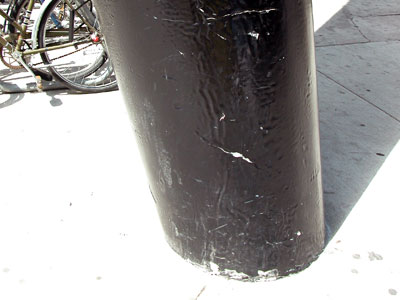 |
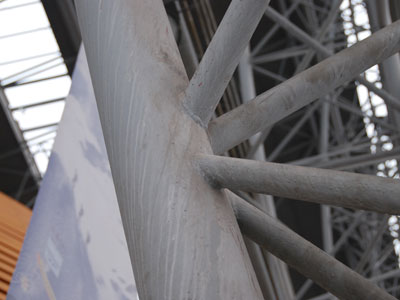 |
The thick intumescent coating on the legs of OCAD has suffered damage. The base of the legs has had to be repaired and refinished, which for the black colour has not been difficult, but colour matching for the other legs has proven to be a challenge. |
The intumescent coating on this Science Centre in China was not properly applied. It would appear that the building was not enclosed when the material was applied, and subsequently it was rained upon. Care must be taken to ensure that materials are properly specified AND applied. |
Care should be taken when using thick coatings in high traffic areas or where they can be subject to vandalism. The damaged intumescent coating must be properly repaired to maintain the required fire resistance rating. Colour matching can also be an issue.
Cementitious/Fibrous Fire Protection
Although not the usual case for AESS installations, cementitious or fibrous fire protection might be used. This could be the case if the steel is located at a distance from view or touch, as in the case of AESS Categories 1 or 2. If such a finish is to be applied, there need not be the same level of surface preparation required and the Matrix should be customized to remove Characteristics very early on in the scheduling of the project to avoid wasted time and expense.
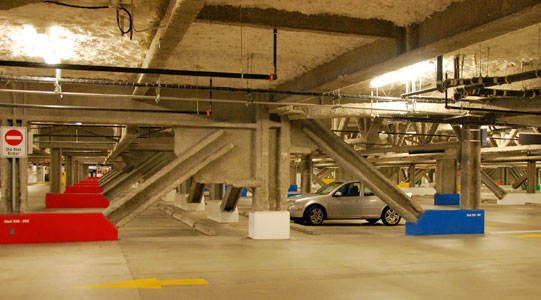 |
This parking garage uses a cementitious method of fire protection. The steel detailing is still expressed, but a much simpler connection language is used. |
